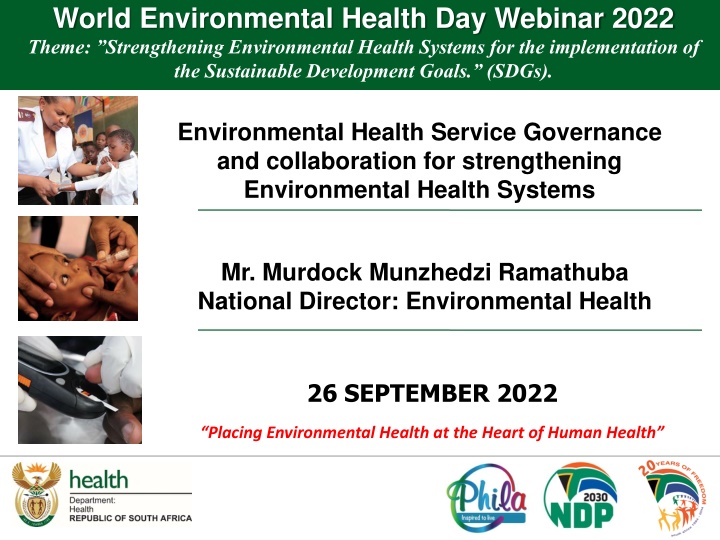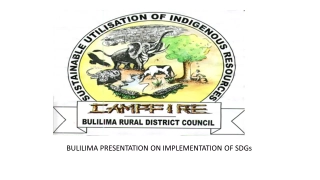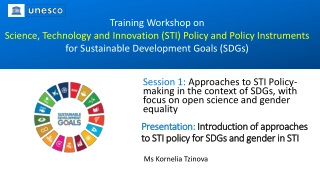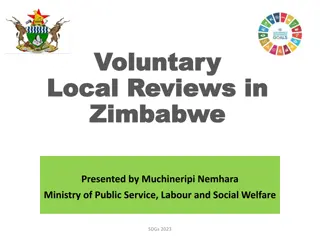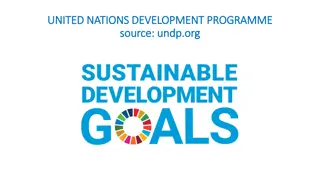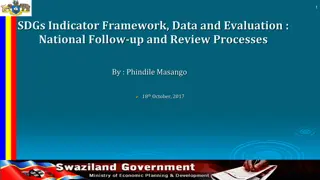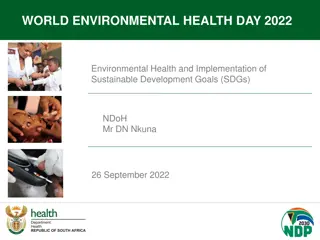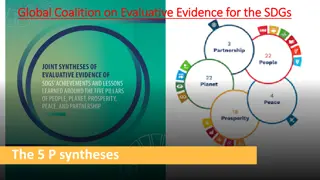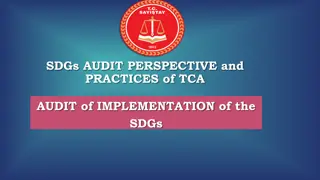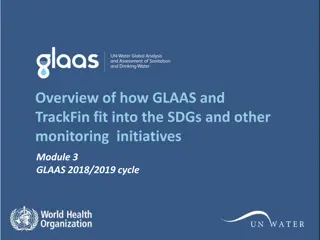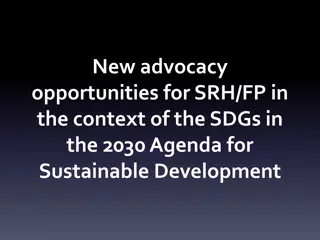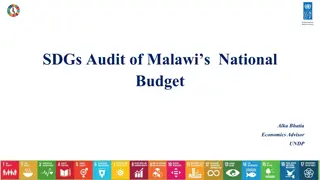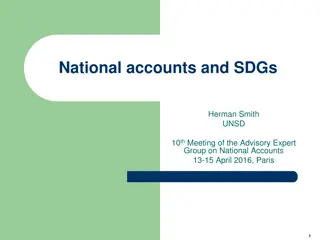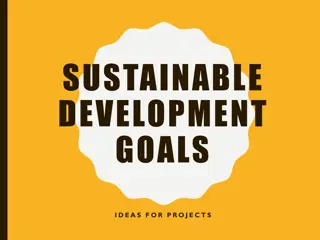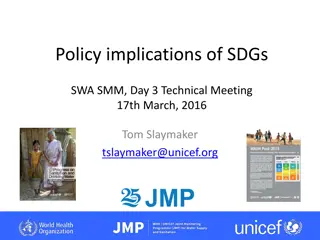Strengthening Environmental Health Systems for SDGs Implementation
This webinar focuses on the pivotal role of Environmental Health (EH) in achieving Sustainable Development Goals (SDGs), emphasizing governance, collaboration, and system strengthening. Understand the shared responsibilities across government spheres and the direct impact EH services have on key SDGs like clean water, sanitation, and climate action.
Download Presentation

Please find below an Image/Link to download the presentation.
The content on the website is provided AS IS for your information and personal use only. It may not be sold, licensed, or shared on other websites without obtaining consent from the author.If you encounter any issues during the download, it is possible that the publisher has removed the file from their server.
You are allowed to download the files provided on this website for personal or commercial use, subject to the condition that they are used lawfully. All files are the property of their respective owners.
The content on the website is provided AS IS for your information and personal use only. It may not be sold, licensed, or shared on other websites without obtaining consent from the author.
E N D
Presentation Transcript
World Environmental Health Day Webinar 2022 Theme: Strengthening Environmental Health Systems for the implementation of the Sustainable Development Goals. (SDGs). Environmental Health Service Governance and collaboration for strengthening Environmental Health Systems Mr. Murdock Munzhedzi Ramathuba National Director: Environmental Health 26 SEPTEMBER 2022 Placing Environmental Health at the Heart of Human Health
OUTLINE OF PRESENTATION Purpose Background Planning and Coordination Roles and Responsibilities Key Work in Progress for Strengthening EH Systems Conclusion 2
PURPOSE OF PRESENTATION To provide an overview of Environmental Health Service (EHS) Governance issues and its impact on delivering effective services to communities. To highlight collaboration arrangements for strengthening Environmental Health (EH) Systems and Service Delivery. 3
BACKGROUND EH plays a pivotal role in the implementation of the SDGs and with a well institutionalized EH System, the targets set will be easily achieved, this is supported by the International Federation of Environmental Health (IFEH). EH Services in the country is a shared responsibility between three spheres of government i.e., national, provincial and local government. The spheres are in terms of the constitution, distinctive, interdependent and interrelated. Therefore, the systems by which environmental health is managed and operates, and the mechanisms by which it, and its officials are held to account at all levels are key. Ethics, risk management, compliance and administration are all aspects involved. 4
BACKGROUND All spheres are involved in health EH systems improvement and strengthening, including discussing, proposing, drafting and final development of Health Policies for their jurisdiction and the country. It is key that each role player plays its roles and responsibilities in Environmental Health Services Delivery and system strengthening. Environmental Health fits directly into SDG 3 (health and wellbeing) due the nature of it being a health services. The EH service fits into the realization of this SDG 3. 5
BACKGROUND (Cont) In addition, seven (7) other SDGs, 19 targets and 30 indicators also have a direct bearing on environmental health. Relevant SDGs are: Goal 6: Clean Water and Sanitation, Goal 7: Affordable and Clean Energy, Goal 8: Decent Work and Economic Growth, Goal 13: Climate Action, Goal 14: Life Below water, Goal 15: Life on land and Goal 17: Partnerships to achieve goals 6
BACKGROUND (Cont) This means that the work done by EHPs is key in not only resolving challenges as a result of factors in the environment that may impact on human health, but to prevent the onset and spread of disease. The Ministry of Health is not directly responsible for the delivery in these (7) SGDs, but improved health outcomes relies on the achievement of these goals by various policy agendas. Environmental health plays a critical role of compliance monitoring of systems in place for the implementation of these SGDs for protection of public health. 7
PLANNING AND COORDINATION The National Department of Health is the custodian of Environmental Health Services ( inclusive of Port Health and Municipal Health Services). The National Health Council (NHC), established under section 22 of the National Health Act, 2003; is the Political structure; leading health services delivery and advising Minister on Health matters, including: Health policy development and implementation; Proposed legislation pertaining to health matters; norms and standards; guidelines; national and provincial integrated health plans; integrated national strategy for health research; and performance of any other function determined by the Minister. Constituted by Minister as Chairperson, Deputy Minister, MECS, Municipal councilor representing organized local government and appointed by the national organization contemplated in section 163(a) of the Constitution; the Director-General and the Deputy Directors-General of the national department; the head of each provincial department; one person employed and appointed by the national organisation contemplated in section 163(a) of the Constitution; and the head of the South African Military Health Service. 8
PLANNING AND COORDINATION Cont At a technical and operational level, there is a Technical structure of the NHC that is constituted of the Director-General, Deputy Director-Generals, Heads of Provincial Departments responsible for Health. The TECH NHC discusses policy and strategic documents impacting on the three spheres of government prior to them being presented to the NHC for consideration and approval. The TECH NHC has subcommittees to discuss related matters and recommend for TECH NHC. Environmental Health related matters are discussed in the National Services Platform Sub Committee of the TECH NHC, co-chaired by DDG: PHC, prior to escalation to the TECH NHC. The Cluster: Environmental Health & Port Health Services leads planning and coordination of EHS in three spheres of government through the Interprovincial Committee which endorses EH Policy and guidelines drafts prior to escalation to Service Platforms Sub Committee of the NHC Tech. 9
PLANNING AND COORDINATION (Cont) The Interprovincial Committee comprises of: Chaired by Cluster Manager: Environmental Health and Port Health Services (EHPHS) Who`s office also provides secretariat services National Officials (EHS, PHS, CDC, FC, HP) Provincial EH Managers & Coordinators (9 Provinces) Municipal Representatives (nominated by Municipalities per Province) SALGA & HPCSA Representatives Other Representatives (SAMHS, DCS, NT) One representative each for Institutions of Higher Learning and Research Institutions. 10
PLANNING AND COORDINATION (Cont) The Inter-Provincial Committee deliberates on: Sharing and alignment of Annual Performance and Operational Plans Exchange and sharing of information Sharing of good/best practices Strengthen collaboration, cooperation & communication Reporting on EH matters such as incidents, outbreaks and DHIS Indicators Discussing, inputting, amending and endorsing draft EH Policy documents, including guidelines, regulations and Acts and Bills. Addressing of gaps and challenges. 11
ROLES AND RESPONSIBILITIES The National Health Act, 2003 (Act No. 61 of 2003) and the Constitution sets out the responsibilities of the three spheres of government in the provision of Environmental Health Services. At a National level: Coordination & Facilitation of implementation of EHS in the country. Health Policy development and review. Regulation, monitoring and support of Provincial & municipal health services. Capacity building and training to EHPs and other relevant stakeholders. These is done without compromising/impeding a municipality s ability or right to exercise its powers or perform its functions 12
ROLES AND RESPONSIBILITIES(Cont At a Provincial Level: Oversight, coordination and support of broader EH and MHS programs. Malaria control and Occupational Health. Inspection of Hazardous substance dealers and control. At a Municipal level: Implementation of 9 elements of EH defined as MHS. Health and Hygiene Education. Environmental health law enforcement services. Conducting environmental health impact assessments, amongst others. Climate Change and Health Adaptation activities for the area of jurisdiction. 13
ROLES AND RESPONSIBILITIES(Cont At a Municipal level cont : To strengthen roles at Municipal level towards achievement of SDGS, some key aspects to be lifted will include: Law enforcement, some municipalities are not keen in implementing it to premises that regardless of guidance and notices remain noncompliant. Appointment and authorization of EHPs per relevant legislation should be strengthened as it remains a challenge impeding enforcement. While Municipalities were assisted to address issues identified related to law enforcement during Norms and Standards assessments, they should also prioritize training of their officials in law enforcement. - - 14
KEY WORK IN PROGRESS FOR STRENGTENING OF EH SYSTEMS Development on an Environmental Health Information System (EHIS). A technical Team has been established at NDoH which will work with team from SALGA and other relevant stakeholders. Provinces and Municipalities have been requested to provide baseline information on available types of information system. A national meeting was postponed from September 2022, finalizing list of stakeholders from municipalities and provinces. Development of the National Environmental Health Act, The Bill. A draft environmental health bill has been finalised and circulated to the drafting team for inputs and finalisation for broader consultation. 15
KEY WORK IN PROGRESS FOR STRENGTENING OF EH SYSTEMS Activities were halted by the emergence of the COVID19 outbreak in 2020 and the urgent need to finalise the Health Regulations below. Collaboration with other stakeholders in implementing EH has produced results Health Regulations development and review during/post COVID-19. Four Health regulations published for Public comments in March for a Month and republished in May for three Months, final closing day was 05August 2022. Over 390 000 public comments were received on Regulations relating to Environmental Health, Regulations relating to Management of Human Remains, Regulations relating to Port Health and Regulations relating to Notifiable Medical Conditions and being processed currently 16
KEY WORK IN PROGRESS FOR STRENGTENING OF EH SYSTEMS Other Environmental Health Regulations in Progress. Regulations Relating to Lead in Paint or Coating Materials to regulates the manufacture, sale, distribution, import and export of all paints or similar coating materials as per Globally Harmonized System of classification and labelling of chemicals Group II Hazardous Substances Declaration, closed 29 July 2022 Group I, category A, Hazardous Substances Declaration, closed 28 June Group I, category B, Hazardous Substances Declaration, closed 28 June Review of the National Environmental Health Norms and Standards Guiding documents such as Vector Control Guidelines, Climate Change and Health Adaptation plan, Norms and standards, Environmental Management Planning etc. Assessments of Municipalities and Points of Entry for compliance with National Environmental Health Norms and Standards, 2015. 17
CONCLUSION A strengthened Environmental Health System will ensure effective and efficient EHS delivery towards achievement of the SDGs in the country. The targets set out in the SDGs will become a reality and achievable through a well defined and institutionalized Environmental Health System. Clear and well-defined roles and responsibilities in execution of EHS will further enhance EHS delivery in achieving the SDGs in the country. Establishment of working groups/task teams for the Inter Provincial Committee to deal with specific aspects of interest as it did with development of the National Environmental Health Bill, will be strengthening EHS and speedup meeting SDGs. 18
THANK YOU END 19
